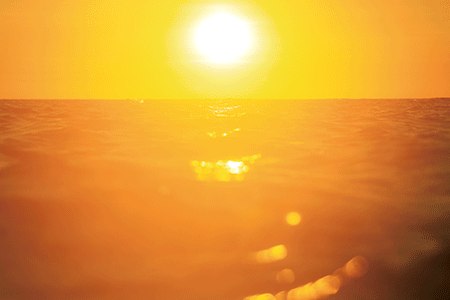2 Landscape Photography Tricks to Transform Your Images On the Spot
Have you ever chanced upon a stunning scene that seemed quite easy to photograph, but realised during playback that despite your best efforts, your shot didn’t seem to do the scene enough justice? Here are two ideas that could help you fix that right on the spot—no extra equipment needed. (Reported by: Minefuyu Yamashita, Jiro Tateno, Digital Camera Magazine)

EOS 5D Mark IV/ EF100mm f/2.8L Macro IS USM/ FL: 100mm/ Aperture-priority AE (f/4, 1/8,000 sec, EV -2.0)/ ISO 200/ WB: Shade
Other equipment: Underwater housing
Photo by: Minefuyu Yamashita
1. Breathe on your lens to make the sun look even brighter
I chanced upon this brilliant sunset one evening. Shooting my usual way would have resulted in a rather bland image, so I decided to breathe on the surface of my lens*. The fog formed creates a soft-focus effect that makes the sun seem to glow brighter.
*Note: To protect your lens from moisture, breathe onto a lens filter instead of directly on the front element. Wipe the fog away thoroughly when you are done!
To enhance the glowing effect, shoot to put the sun out of focus
I used a wider aperture, shot from an angle that just barely grazed the water surface, and placed my focus not on the sun, but on a nearby wave in the middle ground. This effectively creates a bokeh effect in the sun that enhances the glow, especially when combined with the fog from your breath.
Tip: Don’t fog the entire lens
When you fog the entire lens with your breath, it could hide details and make the image look flat, like the one below:
Failed shot: Too much fog all over

The good thing is that you can control where and how much fog forms on your lens! Decide where you want the sun to go in your composition, and then breathe over that part. For the very first image, I breathed over just the top-centre where the sun was so that the fog didn’t cover the details of the waves.

Sunsets and beaches go together. For more ideas and tips on shooting sunsets at the beach, see:
A Dazzling Golden-Blue Sky at Sunset: In-Camera and Post-Processing
Handling Natural Light: Glittering Pebbles on Sunset Beach
2. Use a slow shutter to erase distractions

EOS 5D Mark III/ EF70-200mm f/2.8L IS III USM/ FL: 95mm/ Manual exposure (f/16, 1/3 sec)/ ISO 100/ WB: 4,800K
Photo by: Jiro Tateno
Simplicity draws attention to colours
Clear blue waters, with colours intensified by the reflection of a clear blue midday sky, would catch the eye of any landscape photographer. Add a tree or floating plant in the water to act as visual interest, like the sapling in the above shot, and the image becomes picture perfect.
To emphasise the sky-blue water and the fresh green leaves of the sapling, I decided to use a minimalistic composition that incorporated alot of negative space.
Also see: Minimalist Landscape Photography with the Sky
A slow shutter simplifies the shot further
When I shot with my usual settings, the ripples from the moving water looked distracting. Slowing the shutter speed to 1/3 second not only made these disappear, but also made the reflection of the sapling look clearer and sharper.
With an ND filter and an even longer exposure, you can turn moving water into abstract art! See:
Slow Shutter Art: 300-sec Exposure for a Different View of the Sea
~~~
Need more hacks? Here are some more to try!
On-the-spot hacks for dealing with challenging condition:
3 Situational Hacks by Quick-Thinking Photographers
Hacks from everyday items and DIY props:
2 Everyday Items That Could Transform Your Photos
5 Creative Hacks to Up Your Instagram Game
Homemade Light Diffusers: Different Materials, Different Output
Receive the latest update on photography news, tips and tricks.
Be part of the SNAPSHOT Community.
Sign Up Now!About the Author
A monthly magazine that believes that enjoyment of photography will increase the more one learns about camera functions. It delivers news on the latest cameras and features and regularly introduces various photography techniques.
Published by Impress Corporation
Born in 1979 in Aichi. After gaining experience in jobs such as interior and graphic designing, Yamashita became an independent photographer in 2011. His works have been used in many calendars.
Born in Tokyo in 1975. From around 1990, he came into contact with nature through fly fishing, and took up photography. From 1999, he travelled around the country taking photos with the theme of "Natural Beauty". He currently supplies photos for magazines, books, posters, calendars, and so on. He held an "Okinawa" photo exhibition in 2010, and "Northern Lights - Journey of Light/ Iceland" photo exhibition in 2017.




































